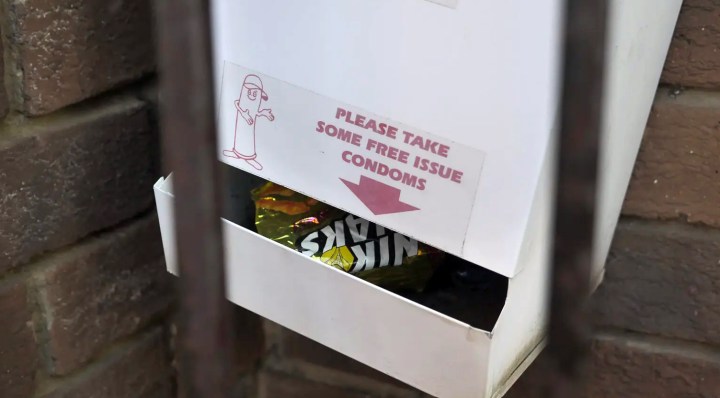SPOTLIGHT
Condom distribution in SA drops dramatically, new figures show

Condom distribution in South Africa has dropped dramatically over the past five years, according to a Spotlight analysis of data recently published in the Health System Trust’s District Health Barometer.
The South African government distributed 45% fewer male condoms in 2022 than it did in 2018. The total number distributed dropped by more than 300 million, from 728 million in the financial year from March 2018 to February 2019 to 403 million in 2022/23. Female condom supply also declined over this period, but not as sharply.
The full extent of the actual decline in condom supply across the country over the past five years has not previously been reported. The DA, though, did raise the alarm about condom supply challenges in Gauteng in April 2023.
Provincial health departments have pinpointed the time required for certification of condoms by the South African Bureau of Standards (SABS) following the start of a new condoms tender in 2022 as a key driver of the decline, yet Health System Trust’s District Health Barometer (DHB) data show that condom distribution figures have in fact steadily declined over the past five years. Similarly, while Covid-19-related supply chain interruptions were a contributing factor to supply shortages at the height of the pandemic, the decline in government-supplied condoms started before the pandemic and continued after those supply chain disruptions were resolved (as shown in the below graph).

The large decline in condom distribution in South Africa is alarming in the context of the country’s ongoing fight against HIV. While other biomedical interventions are now available to protect against HIV (such as HIV prevention pills), condoms should remain a cornerstone of countries’ HIV prevention strategies, according to the World Health Organization.
Research by the University of the Witwatersrand’s Health Economics and Epidemiology Research Office has found that condoms are not only the most cost-effective intervention available to the government to combat HIV, but that provision of condoms is cost saving for the health system.
Where did condom distribution fall the most in 2022?
According to the DHB data, all provinces except for the Free State saw a decline in condom distribution in 2022/23 compared with 2018/19 levels (as shown in the below graph).

The Eastern Cape distributed 65% fewer condoms in 2022/23 than it did in 2018/19, Gauteng and the Northern Cape distributed about 60% fewer, Limpopo 52% fewer and the Western Cape about 46% fewer. With a reduction of about 19% over the five years, the decrease was much less pronounced in KwaZulu-Natal than in the other provinces with large populations.
What caused the decline in supply?
Condoms are tendered nationally by the Department of Health for three years and must be tested and certified by the SABS before distribution.
Neither the national nor the Gauteng health department responded to questions from Spotlight about the reasons for the decline in condom distribution. However, Gauteng’s department has pinpointed SABS certification processes as the culprit for supply shortages in the province. The Gauteng department said in April 2023 that suppliers that received tenders to supply condoms to the public sector were unable to supply condoms to the province while awaiting SABS certification in 2022, resulting in low stock.
Eastern Cape health department spokesperson Sizwe Kupelo told Spotlight in response to questions for this article that in 2022/23 “for most of the year there were no condoms to distribute”.
Kupelo said the decline in condom distribution in the Eastern Cape was due to a combination of lags in supply availability while condom suppliers were awaiting SABS certification, and challenges in delivering condoms to distribution sites in the province.
“2022/23 was the end of the condom supply contract and the period to award a new contract effective from 1st April 2022. This transition experienced a delay in availing the condoms due the SABS quality assurance process that could be finalised only around September 2022,” said Kupelo, adding that the province started to receive condoms from October of the same year.
“The second reason was related to suppliers who were not finding it easy to deliver to Eastern Cape areas due to the high cost of transportation to the identified 26 delivery distribution sites across the province. Suppliers are all based in Gauteng.” This matter had been resolved.
Kupelo added that condom supply in the province is improving. The province had reached 96.7% of its target to distribute 17 million condoms in quarter three of 2023/24 (September to November 2023).
SABS responds
Lungelo Ntobongwana, the acting CEO of the SABS, told Spotlight that all condoms that are distributed nationally by the Department of Health are tested at the bureau’s condom laboratory in Groenkloof, Pretoria. This “is an accredited and dedicated laboratory for the testing of condoms”.
“Downtime or challenges to operations as a result of unplanned disruptions have been experienced on rare occasions and the SABS has incorporated contingency plans to ensure that the testing processes and deliverables would not be negatively impacted.
“The value chain, from the production of condoms to the distribution and usage of condoms, requires the intervention of various role players. When there is a shortage of condoms, it could be due to several reasons and chinks in the value chain. The SABS can categorically state that there are currently no challenges in its laboratory or deliverables regarding the testing of samples,” Ntobongwana said.
Did clinics run out of condoms in 2022/23?
The Health Department insisted in April 2023 that while Gauteng was facing low stocks of condoms, there were no serious shortages in the country.
Surveys by community-lead clinic monitoring group Ritshidze also show that condoms remained available in most facilities throughout the year, but also indicate a pattern of rationing by healthcare workers and clinics. In some cases, they say condoms are only available in public clinics on request, and key populations often face stigma and discrimination when seeking to access condoms and lubricant.
Surveys conducted by Ritshidze in 2022 found that only 55% of sex workers could get enough condoms at public facilities. Ritshidze recommends that “condoms and lubricants should be available at all facilities and can easily be placed in the toilets or other areas of the clinic where people could take them without the fear of being seen and judged by others, or being told to put some back”.
Anele Yawa, the general secretary of the Treatment Action Campaign (a member of Ritshidze), told Spotlight that the organisation faced challenges in its community outreach efforts, when TAC members requested condoms from public health facilities for distribution in communities but were sometimes told there were not enough for this.
Yawa added that people seeking condoms from public clinics are often told they can only take a limited number because of stock availability, and that in some clinics “the condom box is empty, there are no condoms”.
Has the drop in availability affected condom use?
There are some concerning indicators that condom use in the country is declining, which may in part be related to the drastic decline in supply.
The Human Sciences Research Council (HSRC), which conducts regular surveys of HIV knowledge and sexual behaviour in South Africa, recently released early data from its 2022 survey. It showed that teenagers and young adults between 15 and 24 years old reported lower rates of condom use at last sex than in previous survey years. The data presented did not pinpoint a cause for the decline – apart from supply constraints, other factors such as a decrease in people’s perceived risk of contracting and dying of HIV might also play a role.
The HSRC will release its full survey results in April 2024, which are expected to provide more insight into why condom use at last sex declined among 15- to 24-year-olds in 2022.
Another concerning indicator of declining condom use is the reported rise in sexually transmitted infections (STIs) in Gauteng. Spotlight reported in February that this resurgence in reported cases in 2023 is a wake-up call that control and management strategies are not keeping pace with the growing disease burden in South Africa’s most populous province.
In response to the increase in STIs, Gauteng’s health MEC, Nomantu Nkomo-Ralehoko, recommended expanded, consistent condom use, noting a number of factors including non-use of condoms, inconsistent use and the forgoing of condoms by people using pre-exposure prophylaxis (PrEP) as contributors to the rise in STIs. PrEP refers to antiretrovirals taken to prevent HIV infection.
Read more in Daily Maverick: Meet Maya Gokul, South Africa’s female condom high priestess
However, Professor Linda-Gail Bekker, director of the Desmond Tutu Health Foundation, told Spotlight there is no evidence to support the claim that PrEP is leading to lower rates of condom use. She added that the increase in STI diagnoses may be attributed to increased rates of testing in the PrEP era.
“The notion that sexually transmitted infections have suddenly increased in the era of PrEP does not have evidence to support this,” said Bekker, adding that “we have no strong evidence to suggest that people are having more condomless sex than before”.
“The value of condoms as a measure against sexually transmitted infections as well as unwanted pregnancy is not disputed and condoms remain the cornerstone of the HIV response,” she said. “However, we know that for many people, and particularly young women and young men who have sex with men, the choice to use male condoms is not always a given and negotiating condom use may not be easy and can be dangerous.”
This article was published by Spotlight – health journalism in the public interest. Sign up to the Spotlight newsletter.




















Maybe the appendage its used on has declined as well?LOL